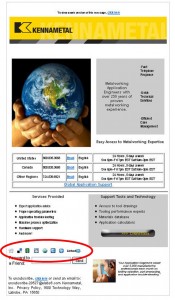Social Bookmarks in B2B Email
Not every marketer’s audience is waiting on Facebook or Twitter, especially marketers in B2B manufacturing. Tim Madel, Manger, Global Ebusiness, Kennametal, is one of these marketers, and his team experiments with social channels anyway.
“We know our current customers might not be using Twitter and Facebook, but we know that the next generation is, and we want to be there and ready for it,” he says.
One way Madel’s team is preparing for a new generation of metal workers is by using Lyris to add buttons to Kennametal’s emails to share content on social bookmarking sites and networks. Although the quick, low-cost tactic does not drive much traffic to Kennametal’s site (referrals from social networks are below 1%), the team hopes the buttons:
– Bring content to correct customers
Many of the team’s email subscribers are purchasing officers, who’re not their target audience. The team adds the buttons so emails can more easily reach people who use Kennametal’s tools.

– Help current and future customers
Customers who prefer to bookmark using Delicious or iGoogle have the option. And if more customers start moving to Twitter, the team will be comfortable sharing its content on the network having experimented. Other buttons the team includes are for:
o Digg
o Reddit
o Newsvine
o LinkedIn
o StumbleUpon
In a sample of two emails, the buttons captured between 40 and 50 clicks each in each email. This is a very low percentage of all emails sent, but the team is undaunted.
“You’re not looking at high percentages, but in our world, that’s a great number to start with,” says Jennifer Altimore, Site Content Manager, Global E-Customer, Kennametal.








